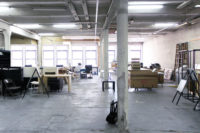It’s been quite the ride for the Solomon R. Guggenheim Foundation and German automaker BMW Group: two years ago the organizations embarked on a global road trip to document how people think about the challenges their cities face, and brainstorm solutions. The results were unveiled last week in Participatory City: 100 Urban Trends from the BMW Guggenheim Lab on view at the Guggenheim Museum in New York City.
Part policy think tank, part happening, part forum, the Lab set up a pop-up space in which residents of three cities—New York City, Berlin, and Mumbai—could voice their opinion about their urban environment, attend a lecture by Bjarke Ingels, or simply hang out under an open-air, carbon fiber canopy designed by Atelier Bow-Wow. The curators used these informal sessions and a smorgasbord of programming to identify and document urban issues. “It was not easy to do. It’s almost like trying to capture a performance, or writing a travel diary,” mused Maria Nicanor, who curated Participatory City. “How do you bring all of that stuff together?”
In an exhibition designed to look like the pop-up Lab, Nicanor distilled the two years of research, thousands of conversations, and scores of digital responses down to the 100 most-talked about words—like crowdsourcing, density, and corruption—and projected them on a wall of the museum’s second level annex. Other walls feature wood panels with information specific to each participating city, and videos of lectures and programming. Even the folding chairs used during the Lab were present at the press preview.
The ideas in Participatory City cover the gamut of urban and design topics, from 3D printers to privacy. Other trends were more esoteric. For example, “10,000 Honks” emerged from the Mumbai Lab, a proposal that each car should have a built-in honk limit to curb the city’s noise pollution. Other trends proved thornier. Gentrification was a top concern in Berlin when the Lab, originally slated to take place in the Prenzlauer Berg neighborhood, was nearly uprooted to a trendier—and allegedly safer—part of the city. However, after public outcry, it occurred at the original locale and sparked even more robust conversations about displacement.
“The Lab was not a pristine project, it was very messy—intentionally messy,” explained David Van der Leer, former Lab curator (he left the Guggenheim to take the helm of New York’s Van Alen Institute in March). “That was really the strength of the project and it helped people to open up.” Nicanor agreed. “This started as a subversive project internally,” she said. “It was interesting that the institution [the Guggenheim] wanted to take the risk and allowed us to do it.”
Part of that risk was originally mitigated by financial support from BMW Group, which, according to the company’s head of cultural engagement Thomas Girst, was their largest cultural project to date. The mobile lab structure alone—first wedged into an alleyway in Manhattan’s East Village and then transported to Berlin—cost more than $3 million to fabricate.
But Participatory City marks the premature conclusion of the BMW Guggenheim Lab experiment. The original intention was to complete an additional two iterations of the cycle, exploring more cities and mounting two more biannual exhibitions by 2016. However, this July BMW Group bade auf wiedersehen to funding the project. “Strategic changes within the company made it necessary to conclude the project with the exhibition, looking at the three cities that the lab had traveled to,” Girst said in a telephone interview, adding, “It made sense to conclude the project as there was so much information.”
Although the project came to an early end, Nicanor hopes that the individual findings will translate into larger projects, providing nodes for further exploration. “The exercise wasn’t about trying to forecast urban trends. This is more this particular moment in time. I don’t think we can ever do the experience justice, especially the human component.”
Participatory City: 100 Urban Trends from the BMW Guggenheim Lab is on view at the Solomon R. Guggenheim Museum until January 5, 2014.






